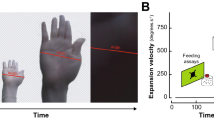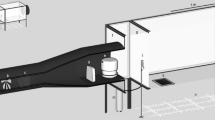Abstract
The rates of mosquito landing on a host-imitating device were measured. The device contained an electric heater to imitate the presence of a warm-blooded animal, a gauze screen impregnated with meat juice, a microphone with an amplifier to record the sounds of mosquito landings and take-offs, and a light meter to record the ambient illumination. In addition, the behavior of mosquitoes near the device was studied by video recording. All the experiments were conducted in the first half of June in evening and morning hours in mixed spruce-birch forests of Moscow region. Audio recordings were digitally analyzed to estimate the landing rates. Significant (more than 50% of the average) quasi-periodic fluctuations of the mosquito landing rate were revealed. The peaks of mosquito activity alternated with drops with an average period of 30 min (20–50 min in different recording sessions). These fluctuations were recorded in calm weather during a gradual change in illumination. Experiments with two similar devices positioned 20 m apart showed that fluctuations of mosquito activity developed independently at each site. The fluctuations in the mosquito landing rate seem to be largely determined by endogenous factors: mosquito females, failing to obtain blood from the host-imitating device, lost interest in it and landed to rest on the nearby vegetation. After 20–50 min, the memory trace of the previous experience gradually faded, and mosquitoes returned to the attracting device thus starting the next peak of activity.
Similar content being viewed by others
References
Alekseev, A.N., Rasnitsyn, S.P., and Vitlin, L.M., “On the Group Behavior of Females of Bloodsucking Mosquitoes (Diptera, Culicidae, Aedes): Observations of the Invitation Effect”, Med. Parazitol. Parazitar. Bolezni 46 (1), 23–24 (1977).
Aschoff, J., Biological Rhythms, Vol. 1 (Plenum, 1981; Mir, Moscow, 1984) [in Russian].
Barashkova, A.I. and Reshetnikov, A.D., “Ecology of Bloodsucking Mosquitoes in the Central Taiga Zone of Yakutia”, Izv. Samar. Nauchn. Tsentra Ross. Akad. Nauk 14 (5), 143–144 (2012).
Barrozo, R.B., Schilman, P.E., Minoli, S.A., and Lazzari, C.R., “Daily Rhythms in Disease-Vector Insects”, Biol. Rhythm Res. 35 (2), 79–92 (2004).
Bezzhonova, O.V., Ivanitskii, A.V., and Fedorova, M.V., “Nocturnal Activity of Mosquitoes (Diptera, Culicidae) in Volgograd and Its Environs”, Med. Parazitol. Parazitar. Bolezni, No. 4, 25–27 (2004).
Chernyshev, V.B., Daily Activity Rhythms in Insects (Moscow State Univ., Moscow, 1984) [in Russian].
Detinova, T.S., Rasnitsyn, S.P., Markovich, N.Ya., et al., “Unification of Techniques for Assessment of Abundance of Bloodsucking Dipterans”, Med. Parazitol. Parazitar. Bolezni 47 (5), 84–92 (1978).
Gornostaeva, R.M. and Danilov, A.V., Mosquitoes (Family Culicidae) of Moscow and Moscow Province (KMK Sci. Press, Moscow, 1999) [in Russian].
Guidelines M.U., Methods of Assessment of the Efficiency of Insecticides, Acaricides, Development Regulators, and Repellents Used as Medical Means of Insect Extermination (Russian Ministry of Health, Moscow, 2007) [in Russian].
Guidelines M.U., Collection and Counts of Bloodsucking Arthropods in Natural Foci of Dangerous Infections, and Material Preparation for Laboratory Study (Russian Ministry of Health, Moscow, 2012) [in Russian].
Gündüz, Y.K., Aldemir, A., and Alten, B., “Seasonal Dynamics and Nocturnal Activities of Mosquitoes (Diptera: Culicidae) in the Aras Valley, Turkey”, Turkish J. Zool. 33, 267–276 (2009).
Jones, M.D.R., “The Automatic Recording of Mosquito Activity”, J. Insect Physiol. 10 (2), 343–348 (1964).
Jones, M.D.R., Cubbin, C.M., and Marsh, D., “Light-on Effects and the Question of Bimodality in the Circadian Flight Activity of the Mosquito Anopheles gambiae”, J. Exper. Biol. 57, 347–357 (1972).
Kawada, H. and Takagi, M., “Photoelectric Sensing Device for Recording Mosquito Host-Seeking Behavior in the Laboratory”, J. Med. Entomol. 41 (5), 873–881 (2004).
Khlyzova, T.A., “The Daily Activity Rhythm of Bloodsucking Mosquitoes (Diptera, Culicidae) under the Southern Taiga Conditions”, in Proceedings of the All-Russia Research Institute of Veterinary Entomology and Arachnology: Collected Papers, (Tyumen, 2006), pp. 201–212 [in Russian].
Klun, J.A., Kramer, M., and Debboun, M., “Four Simple Stimuli that Induce Host-Seeking and Blood-Feeding Behaviors in Two Mosquito Species, with a Clue to DEET’s Mode of Action”, J. Vector Ecol. 38 (1), 143–153 (2013).
Kukharchuk, L.P., Bloodsucking Mosquitoes (Diptera, Culicidae) of Siberia (Nauka, Novosibirsk, 1980) [in Russian].
Lapshin, D.N., A Device for Assessment of Activity of Bloodsucking Mosquitoes. Patent No. 2447657 (2012).
Lopatina, Yu.V., Bezzhonova, O.V., Fedorova, M.V., et al., “The Bloodsucking Mosquito (Diptera, Culicidae) Complex in the West Nile Encephalitis Focus in Volgograd Province. III. Species Feeding on Birds and Man and the Rhythms of Their Nocturnal Activity”, Med. Parazitol. Parazitar. Bolezni, No. 4, 37–43 (2007).
Monchadsky, A.S., “Attacks of Mosquitoes on Man under the Subarctic Natural Conditions and Factors of Their Regulation”, Parazitologiya, No. 12, 123–166 (1950).
Popov, V.M., “Materials on the Ecology of Aedes excrucians Walk. and Aedes cinerius Meig. Mosquitoes in the Forest Zone of Western Siberia”, Med. Parazitol. Parazitar. Bolezni 22 (6), 521–528 (1953).
Raman, D.R., Gerhardt, R.R., and Wilkerson, J.B., “Detecting Insect Flight Sounds in the Field: Implications for Acoustical Counting of Mosquitoes”, Amer. Soc. Agric. Biol. Eng. 50 (4), 1481–1485 (2007).
Redkina, N.V. and Ostroverkhova, G.P., “Bloodsucking Mosquitoes (Diptera, Culicidae) in the Town of Strezhevoi, Tomsk Province”, Trudy Russ. Entomol. O-va 78 (1), 97–106 (2007).
Reshetnikov, A.D., Prokopiev, Z.S., Barashkova, A.I., and Semenova, K.E., “On the Daily Activity of Bloodsucking Dipterans in Northeast Yakutia”, Izv. Samar. Nauchn. Tsentra Ross. Akad. Nauk 11 (1), 147–149 (2009).
Szücs, A., “Applications of the Spike Density Function in Analysis of Neuronal Ring Patterns”, J. Neurosci. Methods 81, 159–167 (1981).
Vinogradova, E.B. and Karpova, S.G., Seasonal and Daily Rhythms of Bloodsucking Mosquitoes (Zool. Inst., St. Petersburg, 2010) [in Russian].
Author information
Authors and Affiliations
Corresponding author
Additional information
Original Russian Text © D.N. Lapshin, D.D. Vorontsov, 2015, published in Zoologicheskii Zhurnal, 2015, Vol. 94, No. 6, pp. 661–669.
Rights and permissions
About this article
Cite this article
Lapshin, D.N., Vorontsov, D.D. Temporal dynamics of host-landing rate in mosquitoes attacking the imitation of a host. Entmol. Rev. 95, 517–524 (2015). https://doi.org/10.1134/S0013873815040168
Received:
Published:
Issue Date:
DOI: https://doi.org/10.1134/S0013873815040168




